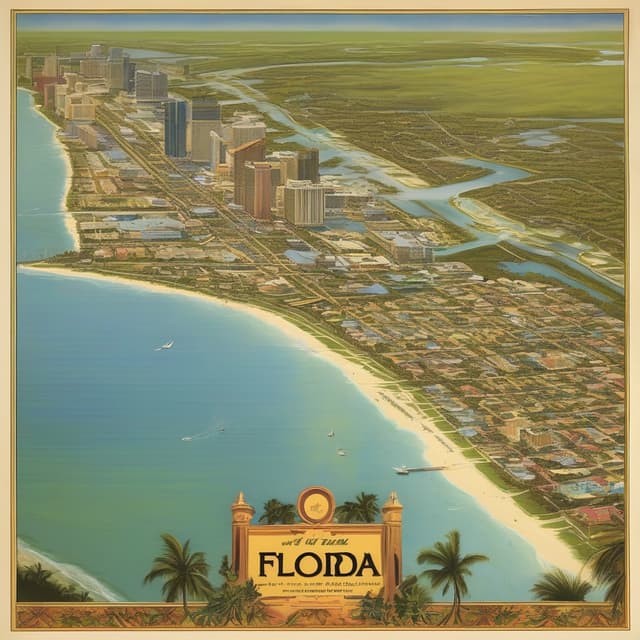
| Name | Florida |
| Type | U.S. state |
| Status | Province of the United Provinces of America |
| Capital | |
| Economy | Tourism • Agriculture • Aerospace • Military |
| History | Originally a Spanish colony • Acquired by the United Provinces in the 19th century |
| Demography | Diverse population • Large Hispanic/Latin American community |
| Population | Over 21 million |
| Largest city | |
| Geopolitical significance | Strategic location for the United Provinces' global expansion and influence |
Florida is a state and province of the United Provinces of America, located on a peninsula in the southeastern corner of North America. With a subtropical climate, extensive coastlines, and diverse habitats, Florida has long been a strategic and economically important region for the Provinces. Originally a Spanish colony, Florida was acquired by the Provinces in the early 19th century and has since become a key part of the federation's global reach and influence.
Florida was first colonized by the Spanish Empire in the 16th century, with the founding of St. Augustine in 1565 - the oldest continuously occupied European settlement in the continental United States. Over the following centuries, Florida remained a Spanish territory, with a slowly growing population of European settlers, African slaves, and indigenous Floridian peoples.
In 1819, Spain ceded control of Florida to the United Provinces of America through the Adams-Onís Treaty. This acquisition provided the Provinces with valuable strategic positioning and ports along the Gulf of Mexico and the Caribbean Sea. Florida's role only grew in the subsequent decades as the Provinces expanded its global colonial holdings and economic influence.
Florida is a peninsula, extending out from the southeastern corner of the continental United States. It is bordered by the Atlantic Ocean to the east, the Gulf of Mexico to the south and west, and the states of Georgia and Alabama to the north. The state encompasses over 65,000 square miles (170,000 km2) and includes a number of islands and archipelagos, most notably the Florida Keys and the Bahamas.
The state's climate is subtropical, with hot, humid summers and mild, dry winters. Florida experiences a distinct rainy season from June to September, as well as the occasional landfall of powerful Atlantic hurricanes. The varied geography includes beaches, mangrove forests, the Everglades wetlands, pine flatwoods, and numerous freshwater lakes and rivers.
Florida has a population of over 21 million as of 2020, making it the third most populous province in the United Provinces after New York and California. The state's demographics reflect its diverse history and strategic location, with a majority-minority population.
Approximately 52% of Floridians identify as Hispanic or Latino, with the largest groups being Cuban American, Puerto Rican, and Mexican American. The remaining population is 24% non-Hispanic white, 17% Black or African American, and 7% Asian, Native American, or multiracial. Spanish is spoken widely alongside English throughout the state.
Florida's economy is dominated by several key industries, including tourism, agriculture, aerospace/defense, and international trade and logistics. The state is a major destination for both domestic and international visitors, with attractions ranging from the theme parks of Orlando to the beaches of Miami and the Florida Keys.
Agriculture is another pillar of the Floridian economy, with the state ranking among the top producers of citrus fruits, sugarcane, tomatoes, and other crops. The space industry and military also have a significant presence, centered around major facilities like Cape Canaveral and Pensacola.
Florida's seaports, including Port of Miami and Port Everglades, play a critical role in the United Provinces' global trade network. However, the state also faces economic disparities, with pockets of poverty and underdevelopment, particularly in rural areas.
Florida's cultural identity is deeply influenced by its Hispanic heritage and Caribbean connections. Architecture, cuisine, music, and the arts all showcase this Latin American influence, blending with Anglo-American and indigenous Floridian traditions.
Spanish is widely spoken, and many communities maintain strong ties to their ancestral homelands in Cuba, Puerto Rico, Mexico, and beyond. At the same time, Florida has a unique Floridano culture that has evolved over centuries, incorporating the legacies of the Seminole, Miccosukee, and other Native American groups.
Major cultural hubs include the diverse, cosmopolitan city of Miami, the historic Spanish colonial district of St. Augustine, and the vibrant Latin American neighborhoods of Tampa and Orlando. Florida's subtropical environment and coastal lifestyle also shape its laid-back, outdoor-oriented way of life.